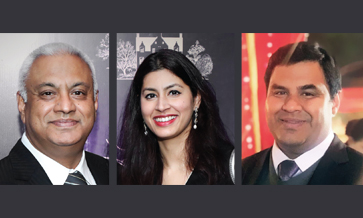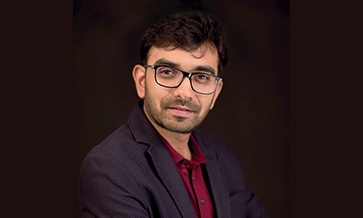Unfazed by her hectic schedule of master classes and panel discussions during the Expo, Sonal Holland, India’s only Master of Wine and Founder of Sonal Holland Wine Academy and SoHoWines Consulting LLP, sat down to a fire-side chat with Brews&Spirits magazine. Excerpts:
What inspired you to pursue the Master of Wine title? What were its biggest challenges?
I was working as director of sales at a NASDAQ-listed Fortune 500 company 16 years ago. However, I felt that my job wasn’t doing justice to my skill set. I wanted to give my career a new direction. That’s when I chanced upon the wine industry in India. It was a great opportunity to be someone in a fresh new industry, learn something new and carve out my own niche.
After 10 years of studying wine, I finally became India’s first (and only) Master of Wine, a title currently held by just 414 people all over the world. The journey was definitely not an easy one. To complete my education, I had to stay away from my home and family. Being separate from my 2-year-old daughter for my studies was the hardest part of this journey. Since I didn’t have a peer group to study with or learn from, it gave me a sense of isolation.
Why did you choose to pursue Master of Wine over a Master Sommelier qualification?
A sommelier works on the floor, or is responsible for beverage revenue. The Master Sommelier is equally challenging to pass, has practical skills exams which focus on service, dining room and cellar management.
On the other hand, anyone working in any wine-related profession can pursue the Master of Wine: writers, educators, consultants, event curators or entrepreneurs.
The Master of Wine theoretical and blind tasting exams evaluate your knowledge with a fine-toothed comb on all aspects, from viticulture, wine-making, business of wine, current trends in the global industry, as well as your skill in comparing styles of wines from around the world and deducing the wine in the glass.
What were you paid on your first job in wine?
I got ?8,000 for delivering a 2-hour wine workshop to enthusiasts at Tendulkar’s restaurant in Colaba, Mumbai. I feel I got a sign from the universe, telling me that I was on the right path!
How did you launch yourself as a wine professional?
In 2009, I launched my first ever business as a wine professional, the Sonal Holland Wine Academy, to impart world-class wine education at affordable rates and create a cadre of qualified wine professionals for the rapidly expanding F&B and wine industry in India.
What are the biggest changes you have seen in the Indian wine industry?
The biggest transformation is in the quality of wines that we produce domestically. Another big change has been the ever-increasing availability of imported wines, which now make up for 30% of the wines consumed in India, and this number is bound to grow rapidly in the next few years.
SoHoWines Consulting LLP is purposefully contributing to the transformation of the Indian wine market’s landscape by helping globally renowned wine brands enter and gain a strong foothold in the country while offering Indian consumers a chance to indulge in the global wine culture.
What are the biggest challenges and opportunities for Indian wines?
The biggest challenge has to be climate change: global warming is changing grape-growing patterns in cool-climate regions like Burgundy, Barolo, Champagne, etc. These are producing excellent vintages year after year now since grapes are ripening and developing more flavour concentration due to warmer climate. A region like England, known for its cold weather, is now producing astonishingly good wines!
However, if this pattern continues, the climate will become too hot, the fruit will move through its life cycle rapidly and characteristics like tannins won’t develop properly, while acidity will drop too. This could lead to the production of flat and dull wines.
The second challenge is the dominance of just a couple of producers in the India market. To motivate brands to keep innovating and striving for excellence, we launched the India Wine Awards, to create the ultimate guide for oenophiles to indulge in the best-in-class domestic and international wines available in the country.
Today, India is also an emerging wine producer that cannot be ignored. Wine is seen as a symbol of sophistication and aspirational living in India. This is a great opportunity for the industry to create a loyal consumer base and brand recall, which can consolidate wine’s future as a mainstream beverage.
What advice do you have for aspiring wine professionals?
Invest in yourself, as it pays the highest interest, and invest in upgrading your knowledge, enhancing your skills and broadening your experiences. It is also very important to network and expand your social and professional circle. Fraternising with industry people can often present you with opportunities that might otherwise not come your way.
What global trends influence the Indian wine industry?
The global wine industry is focussing on sustainable wine-making right now. Several Indian brands, such as Sula, have committed to responsible wine-making in eco-friendly and cost-effective ways.
Use of renewable energy sources, water harvesting, organic farming techniques, recycling of packaging and solid waste management are also areas of learning.
Several Indian brands are choosing screw caps over corks and launching products like canned wines. I would also like to see them move from heavy glass bottles to lighter ones as it will reduce their carbon footprint.
What are some of the biggest wine myths?
One of the most popular wine myths is that expensive wines are better in terms of taste and quality. Cost never guarantees quality. Even the most entry-level wine made by a trusted producer will be well-made and taste good. So, make your purchasing decision based on the wine producer, not the price tag.
Another popular myth is that all wines age gracefully. Almost 95% of the wines produced all over the world are meant to be consumed young and fresh.
Excess consumption of wine is not good for our bodies. A standard 150-ml pour of wine contains up to 150 calories. If you’re guzzling down a bottle of wine in one sitting, then the harmful effects will outweigh any health benefits that the wine may offer.
What’s your take on pairing of Indian food with wines?
Indian cuisine is so diverse that for every style of wine, there’s a dish that will pair well with it! Indian cuisine brings out the depth of flavours in fine wine beautifully. Stop worrying about creating a perfect pairing. Drink the wine you love and eat the food you want.
When you’re not drinking wine, what do you prefer drinking?
I love tea; it is a reminder to be in the moment, rejuvenate and take charge of things. When I’m not tasting wine, I like to drink whiskey. Sake also intrigues and excites me. But I’m a firm advocate of moderate drinking: focus on creating good memories, instead of intoxication.
What is the most exciting bottle of wine in your collection?
A Harlan Estate 2002 and a Château Haut-Brion 1982. Both come from iconic wine producers and incredible vintages.
If there’s one person in the world with whom you’d like to share a glass of wine with…
Shah Rukh Khan, of course!














